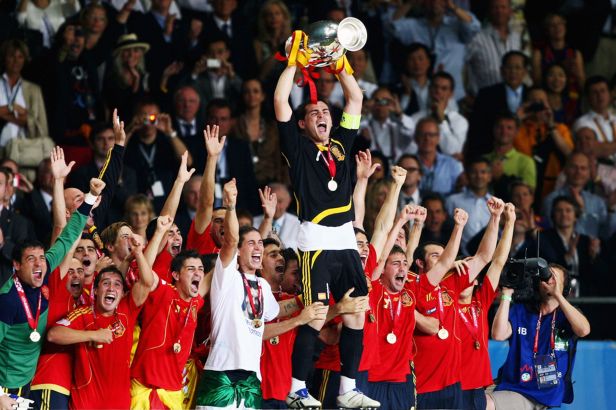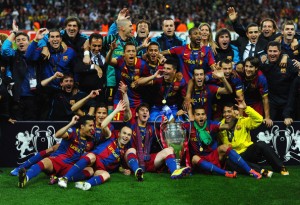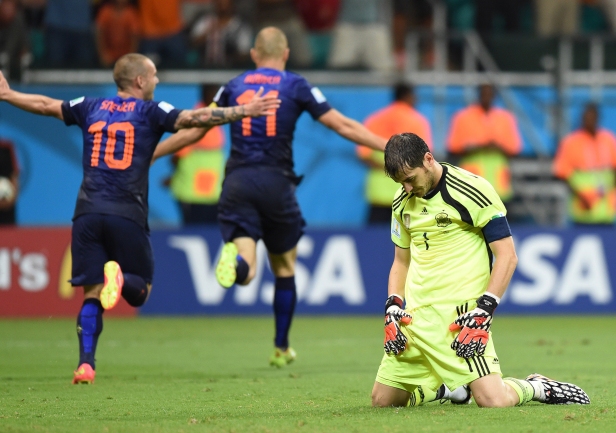
I am shocked. Actually, I’m beyond shocked. I can’t even come up with a word to describe this feeling I’m experiencing after having witnessed the reigning world champions lose consecutively 1-5 and 0-2 to knock them out of the World Cup. And I can honestly say that every single person in the entire world is just as surprised as I am. If someone says that they’re not, they’re a liar. And I mean that.
Who would have predicted that the greatest national team dynasty to ever exist would get absolutely obliterated by the Dutch team they beat in 2010 to lift the trophy, the Dutch team that crashed out of the 2012 European Championships? Who would have predicted this epic assembly of some of the greatest footballers of our time would lose (and get shut out) by a Chile team that, albeit extremely talented, didn’t even come close to having the amount of superstars that Spain has been accustomed to? Who would have predicted that today, on June 18th, we would be talking not about how Spain would breakdown Croatia in the Round of 16, but rather how Spain will move forward from this embarrassing display at the 2014 World Cup? Certainly not me free unblocked games.

Yet, despite all predictions, statistics, opinions, simulations, facts, figures, graphs, diagrams, and articles made prior to the World Cup, Spain are out. In the group stage.
While normally I condemn hasty conclusions and sweeping generalities, I must admit: I agree with the general public on this one. An era is over. It’s not just the fact that Spain lost twice, but rather how they lost. And how they lost in the Confederations Cup final. And how Barcelona, the core of the Spanish side, have finally come back down to earth (As a Real Madrid fan, I’m praising The Lord on that one). And how the Golden Generation of Spanish Football is past their prime. The Spanish downfall hasn’t happened over night, all the signs have been pointing to it for the past couple of years, unfortunately it’s just finally happened fully.
Let me be clear. Spain does not “suck.” They are without a doubt still one of the top ten teams in the world, if not one of the top five. There is no way a team wins three consecutive major tournaments, and the next day suddenly becomes awful. There is no way that a team who has absolutely destroyed the rest of the world for the past six years becomes terrible overnight. They simply are no longer the best team in the world, and they haven’t been for a while now. At their peak though, they were the greatest national team to ever exist.
Let’s break down the past 6 years.
In 2008, Spain win their second Euro, their first since 1964 and second-ever major title. Simultaneously, things at FC Barcelona become abysmal because they are the worst team to ever have stepped foot on this planet and blue and red stripes are tacky HALA MADRID heat up in epic proportions as Lionel Messi storms onto the football stage in dramatic fashion, accompanied by genius coach Pep Guardiola. Why is the Barcelona development important? Because aside from a few players, the team at the Catalan club is almost entirely Spanish. This allows the players, specifically the midfield, to gel as unit 24/7/365 and develop into the most talented group of players to ever play together simultaneously for both club and country.

In the years that lead up to the 2010 World Cup, Barcelona goes on an absolute rampage of success as they win trophy after trophy, a ridiculous campaign that included the first ever “sextuple” by a football club in a calendar year. All the while, the Spanish core of this Barcelona team develops and develops as they play game after game with each other. They learn each other’s secrets, tendencies, styles, and movement. They become so cohesive, that they are literally able to predict what their teammate will do next and plan accordingly. Their prowess as a unit becomes so incredibly perfect that they have a playing style named after them (See: tiki taka) and boast the best possession stats the world has ever seen.

When it comes time for Del Bosque to coach his Spanish squad in the 2010 World Cup, all he has to do is fill the gaps with Real Madrid players and he has a team that knows each other better than any national team has ever before. This is the key to Spain’s success. And here’s why.
The biggest difficulty in playing for a national team is that you have almost no time whatsoever to develop a system and play together as a unit. Soccer, sorry I mean Football, is a game won partially by talent, but more so by tactics and chemistry. Football requires seamless transition, perfect movement off the ball, and knowledge of your teammates movements. Football, although it appears obvious, requires immense amounts of teamwork. Therefore, playing every other month with a group of unfamiliar guys, that happen to be the same nationality as you, becomes tricky because, aside from those rare games, you don’t play with them too often. This is what made Spain so special in 2010. They didn’t have that problem. Their starters had all played together for years and had the kind of national team chemistry the world may never witness ever again. Del Bosque didn’t have to rush to develop and implement a simple system that he could teach to his squad in the short training camp before the Cup, he just had to tweak the “tiki-taka” and insert a few extra players. Boom. Done. Best national team ever. They win the World Cup.
The years in between the 2010 Cup and the 2012 Euros is more of the same from Spain and Barcelona. More success. More wins. More chemistry. For Barcelona, more trophies. More everything-that-makes-a-team-click. The only reason that reporters and fans alike have any reason to doubt that Spain won’t win the 2012 European Championship is simply because we have never seen anything like this before. We’ve never encountered success of this magnitude. It’s foreign. We don’t know what to say or do with this Spanish squad that, for all intents and purposes, is perfect. So what do we do? We critique it and doubt it. Man, are we wrong. Spain wins the 2012 Euros. Easily. Hell, they beat Italy 4-0 in the finals!

And with that win, Spain completes two “firsts”. The first “first”: The only team to have ever won consecutive European Championships. The Netherlands’ Total Football never did that. Germany and Franz Beckenbauer never did that. The four-time world champions Italian team never did that. The five-time world champions Brazil never did that (haha get it? it’s funny cause they’re in South America… I hate myself). No one. Except Spain. The second “first”: The only team to have ever won three consecutive major tournaments. Italy and Brazil won consecutive World Cups in 1934/1938 and 1958/1962 respectively, but they failed to win their continent’s respective championship in between. And even as impressive as winning two World Cups in a row is, it was done at a time where the level of football was absolutely no where near where it is today. That’s another aspect of Spain’s Reign of Terror that is so special. They won three major titles in a row at a time where Football was (and continues to be) at its highest level ever. They didn’t beat awful sides. They beat extremely talented, well-organized, football teams that would have won titles in any other time in history except during Spain’s Reign of Supremacy.
The past six years is what makes this 2014 World Cup Spanish fiasco so hard to stomach. The greatest national team to have ever played together (I’m going to keep calling them that until it sinks in) has finally shown that it is mortal during this past week. For the first time in over half a decade, we have seen a scratch in the other wise blindingly brilliant golden armor that is the Spanish national team. (It should be noted that with all the trophies and medals that the team and players on Spain have won since 2008, they very feasibly could make a full size suit of armor, no joke). What caused this scratch? One word: Time.
The perennial enemy to the human race.
With each passing day, the Golden Generation got older and slower, the rest of the World started to figure out how to stop Spain, and they rest of the world simply got better while Spain drifted slightly from perfection. No longer are the passes perfect to the millimeter. No longer do Xavi and Iniesta seem immortal. No longer is San Iker Casillas perfect (although he’s still pretty damn close and anyone who wants to argue with me on that Casillas point can come find me). The Spanish Reign of Perfection has ended.
Why do I say that?
Why am I so definitive?
Because 2013 and 2014 have proven that that is true. Starting in 2013, we witnessed the deterioration of FC Barcelona as Guardiola left, the rest of Europe figured out how to beat them, and they lost their edge. Correction: the core of the Spanish National Team lost their edge. Starting in 2013, we witnessed Spain’s loss to Brazil in the Confederations Cup final and the imperfect, albeit still exceptional, play that followed in the year after. Spain seemed to be slowing down, not making all the passes they used to. Time met up with España. The recent ending of Spain’s run of excellence has been a year in the making, we were just too hopeful and naive to believe it was actually true.

Spain’s unsuccessful run in the 2014 tournament is nothing to rejoice in (as many of the people I follow on Twitter fail to realize). We have just witnessed the literal end of an era. And hating the team for hatred’s sake is not what a true fan would do, nor is hating the team just because they are good. Take pride in the fact that you were alive to witness and watch this squad. It will truly be something you will tell your grandchildren about, I know I will.
With all of this in mind, it is truly a tragedy that Spain are out of the World Cup in the group stage this year. They are absolutely without a doubt THE best national team to have ever walked this Earth, and their dynasty is more than likely over.










